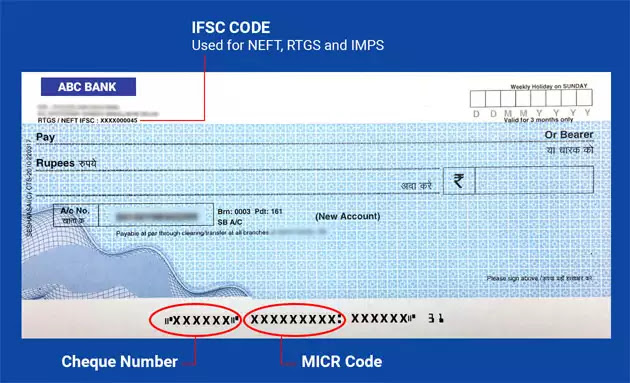IFSC Code: Find IFSC, MICR Codes
IFSC Code:
Why is an IFSC code required?
The IFSC code is used to perform electronic fund transfers across various banks in India. Most major bank branches involved in bank-to-bank electronic payments have a unique IFSC number. The IFSC code is used by banks to identify the source and target bank branches for fund transfer. It is also used to exchange messages and information across the banks.What is MICR Code?
Next three digits: The next three digits of the MICR code is used to identify the bank
Last three digits: The last three digits of the MICR code is used to identify the bank branch
What is the use of MICR Code?
MICR code helps in processing of cheques by machines. This helps in faster processing of cheques. MICR is required to be mentioned in various financial transaction forms such as investment forms or SIP form or forms for transfer of funds etc.
How is the MICR Code used?
MICR code is very commonly used in the manual fund transfer process. After a cheque is deposited by recipient in his or her bank, recipient bank process the cheque, and sends a transfer of funds request to source bank. The cheque is physically sent along with the transfer request to the source bank. After source bank validates the cheque, funds are credited to the recipients bank.
The MICR code helps automating the clearance process, this results in faster fund transfer. As the MICR code can be read by a special cheque reading machine, not only this helps in speeding up the fund transfer process, it also minimizes human errors and offers good protection against fraud. These days as MICR code is quite prominent, any cheque or DD not having a MICR code is easily recognized as a fake cheque or DD.
Benefits of Electronic Fund Transfer vs Manual Fund Transfer:
In a manual fund transfer, there are multiple steps required to complete the process, which results in needing more time, in Electronic, process is done in a much lesser time and protects from fraud. RBI, the central bank of India has assigned the maximum time for a fund transfer by cheque, fixing maximum 3 working days for cheques to be cleared. Cheques which are inter-state or inter-city, commonly known as outstation cheques are allowed maximum period of 7,10 or 14 days depending on the distance between source and receiving banks. This means the maximum time allowed for a outstation bank in a remote location is 14 days. At times, cheques get lost in transit in which case a cheque must be re-issued. Some banks charge service fee for outstation cheques to cover incidental expenses to manually transfer cheques.
A cheque number is the 6-digit number assigned to each cheque leaf to make it unique. It is commonly written on the left-hand side at the bottom of the cheque.
What are the form of electronic fund transfer?
IMPS: The IMPS is the new electronic fund transfer option which can be used for transferring funds 24x7 including Sunday and even bank holidays.
The NEFT and RTGS transactions are governed by RBI while IMPS transactions are governed by the NPCI.
How can I initiate an electronic fund transfer?
The most common way to make an electronic fund transfer is through an online bank account. It is common for most banks to have an authorization process in place to prevent frauds.List of Full Form for words used in this article:
| Full form of RBI | Reserve Bank of India |
| Full form of RTGS | Real Time Gross Settlement |
| Full form of NEFT | National Electronic Fund Transfer |
| Full form of IMPS | Immediate Payment System |
| Full form of DD | Demand Draft |
| Full form of NPCI | National Payments Corporation of India |
| Full form of IFSC | Indian Financial System Code |
| Full form of ATM | Automated Teller Machine |
External links:
- Find IFSC of Banks' Branches on Reserve Bank of India's Website
- List of NEFT Enabled Bank Branches (with IFSC) on Reserve Bank of India's Website
Most Popular banks in India
| (SBI) State Bank of India | Union Bank of India. | HDFC Bank Ltd. |
| Bank of Baroda | ICIC Bank Ltd | Indian Bank |
| Allahabad Bank | Bank of India | Axis Bank |
| Punjab National Bank | Central Bank of India | Canara Bank |
Disclaimer
We have tried really hard to ensure that the information on this site is accurate. However, we cannot guarantee the accuracy of all information and we will accept no liability for any loss or damage incurred. We shall also not be liable for your use or inability to use the site or the information or services that it contains.
Please note that we are not in any way affiliated with the RBI who is responsible for issuing and managing IFSC and MICR codes, and you are advised to confirm each IFSC codes with your bank before initiating any transaction. We cannot be held responsible or liable for any loss or damage, as a result of incorrect or incomplete information derived from this post.
What is WPS? How are employees guaranteed salaries in UAE?


